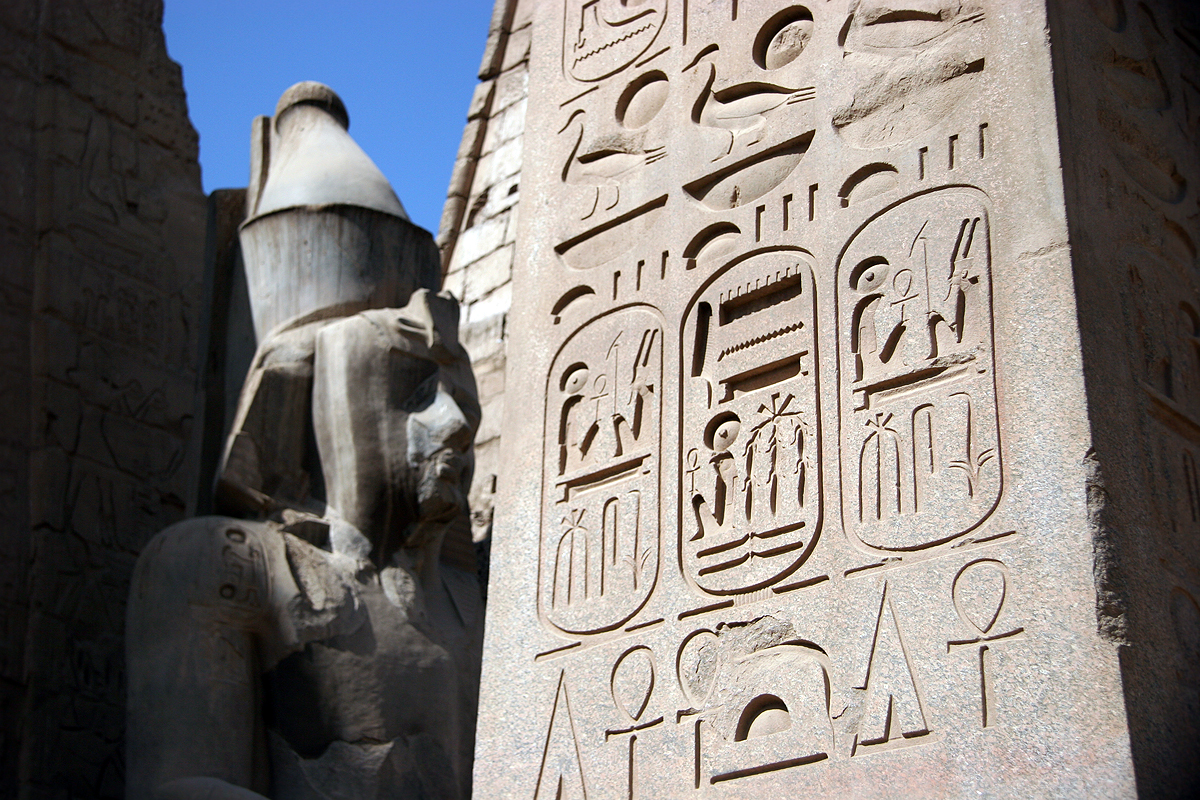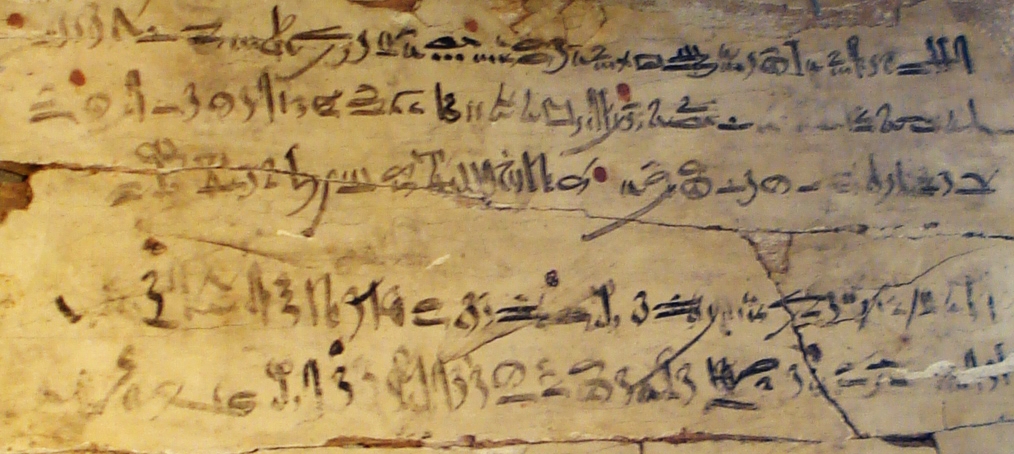|
Hieroglyphic
Egyptian hieroglyphs (, ) were the formal writing system used in Ancient Egypt, used for writing the Egyptian language. Hieroglyphs combined logographic, syllabic and alphabetic elements, with some 1,000 distinct characters.There were about 1,000 graphemes in the Old Kingdom period, reduced to around 750 to 850 in the classical language of the Middle Kingdom, but inflated to the order of some 5,000 signs in the Ptolemaic period. Antonio Loprieno, ''Ancient Egyptian: A Linguistic Introduction'' (Cambridge: Cambridge UP, 1995), p. 12. Cursive hieroglyphs were used for religious literature on papyrus and wood. The later hieratic and demotic Egyptian scripts were derived from hieroglyphic writing, as was the Proto-Sinaitic script that later evolved into the Phoenician alphabet. Through the Phoenician alphabet's major child systems (the Greek and Aramaic scripts), the Egyptian hieroglyphic script is ancestral to the majority of scripts in modern use, most prominently the Latin and ... [...More Info...] [...Related Items...] OR: [Wikipedia] [Google] [Baidu] |
Egyptian Language
The Egyptian language or Ancient Egyptian ( ) is a dead Afro-Asiatic language that was spoken in ancient Egypt. It is known today from a large corpus of surviving texts which were made accessible to the modern world following the decipherment of the ancient Egyptian scripts in the early 19th century. Egyptian is one of the earliest written languages, first being recorded in the hieroglyphic script in the late 4th millennium BC. It is also the longest-attested human language, with a written record spanning over 4000 years. Its classical form is known as Middle Egyptian, the vernacular of the Middle Kingdom of Egypt which remained the literary language of Egypt until the Roman period. By the time of classical antiquity the spoken language had evolved into Demotic, and by the Roman era it had diversified into the Coptic dialects. These were eventually supplanted by Arabic after the Muslim conquest of Egypt, although Bohairic Coptic remains in use as the liturgica ... [...More Info...] [...Related Items...] OR: [Wikipedia] [Google] [Baidu] |
Ancient Egyptian Literature
Ancient Egyptian literature was written in the Egyptian language from ancient Egypt's pharaonic period until the end of Roman domination. It represents the oldest corpus of Egyptian literature. Along with Sumerian literature, it is considered the world's earliest literature. Writing in ancient Egypt—both hieroglyphic and hieratic—first appeared in the late 4th millennium BC during the late phase of predynastic Egypt. By the Old Kingdom (26th century BC to 22nd century BC), literary works included funerary texts, epistles and letters, hymns and poems, and commemorative autobiographical texts recounting the careers of prominent administrative officials. It was not until the early Middle Kingdom (21st century BC to 17th century BC) that a narrative Egyptian literature was created. This was a "media revolution" which, according to Richard B. Parkinson, was the result of the rise of an intellectual class of scribes, new cultural sensibilities about individuality, ... [...More Info...] [...Related Items...] OR: [Wikipedia] [Google] [Baidu] |
Proto-Sinaitic Script
Proto-Sinaitic (also referred to as Sinaitic, Proto-Canaanite when found in Canaan, the North Semitic alphabet, or Early Alphabetic) is considered the earliest trace of alphabetic writing and the common ancestor of both the Ancient South Arabian script and the Phoenician alphabet, which led to many modern alphabets including the Greek alphabet. According to common theory, Canaanites or Hyksos who spoke a Semitic language repurposed Egyptian hieroglyphs to construct a different script. The script is attested in a small corpus of inscriptions found at Serabit el-Khadim in the Sinai Peninsula, Egypt, dating to the Middle Bronze Age (2100–1500 BC). The earliest Proto-Sinaitic inscriptions are mostly dated to between the mid-19th (early date) and the mid-16th (late date) century BC. However, the discovery of the Wadi el-Hol inscriptions near the Nile River indicates that the script originated in Egypt. The evolution of Proto-Sinaitic and the various Proto-Canaanite scripts ... [...More Info...] [...Related Items...] OR: [Wikipedia] [Google] [Baidu] |
Hieratic
Hieratic (; grc, ἱερατικά, hieratiká, priestly) is the name given to a cursive writing system used for Ancient Egyptian and the principal script used to write that language from its development in the third millennium BC until the rise of Demotic in the mid-first millennium BC. It was primarily written in ink with a reed pen on papyrus. Etymology In the second century, the term ''hieratic'' was used for the first time to describe this Ancient Egyptian writing system by the Greek scholar Clement of Alexandria. The term derives from the Greek for "priestly writing" ( grc-koi, γράμματα ἱερατικά) because at that time, for more than eight and a half centuries, hieratic had been used traditionally only for religious texts and literature. ''Hieratic'' can also be an adjective meaning " or associated with sacred persons or offices; sacerdotal." Development Hieratic developed as a cursive form of hieroglyphic script in the Naqada III period of Ancient ... [...More Info...] [...Related Items...] OR: [Wikipedia] [Google] [Baidu] |
Demotic (Egyptian)
Demotic (from grc, δημοτικός ''dēmotikós'', 'popular') is the ancient Egyptian script derived from northern forms of hieratic used in the Nile Delta, and the stage of the Egyptian language written in this script, following Late Egyptian and preceding Coptic. The term was first used by the Greek historian Herodotus to distinguish it from hieratic and hieroglyphic scripts. By convention, the word "Demotic" is capitalized in order to distinguish it from demotic Greek. Script The Demotic script was referred to by the Egyptians as ', "document writing," which the second-century scholar Clement of Alexandria called , "letter-writing," while early Western scholars, notably Thomas Young, formerly referred to it as " Enchorial Egyptian." The script was used for more than a thousand years, and during that time a number of developmental stages occurred. It is written and read from right to left, while earlier hieroglyphs could be written from top to bottom, left to right, ... [...More Info...] [...Related Items...] OR: [Wikipedia] [Google] [Baidu] |
Hieratic
Hieratic (; grc, ἱερατικά, hieratiká, priestly) is the name given to a cursive writing system used for Ancient Egyptian and the principal script used to write that language from its development in the third millennium BC until the rise of Demotic in the mid-first millennium BC. It was primarily written in ink with a reed pen on papyrus. Etymology In the second century, the term ''hieratic'' was used for the first time to describe this Ancient Egyptian writing system by the Greek scholar Clement of Alexandria. The term derives from the Greek for "priestly writing" ( grc-koi, γράμματα ἱερατικά) because at that time, for more than eight and a half centuries, hieratic had been used traditionally only for religious texts and literature. ''Hieratic'' can also be an adjective meaning " or associated with sacred persons or offices; sacerdotal." Development Hieratic developed as a cursive form of hieroglyphic script in the Naqada III period of Ancient ... [...More Info...] [...Related Items...] OR: [Wikipedia] [Google] [Baidu] |
History Of Writing
The history of writing traces the development of expressing language by systems of markings and how these markings were used for various purposes in different societies, thereby transforming social organization. Writing systems are the foundation of literacy and literacy learning, with all the social and psychological consequences associated with literacy activities. In the history of how writing systems have evolved in human civilizations, more complete writing systems were preceded by ''proto-writing'', systems of ideographic or early mnemonic symbols (symbols or letters that make remembering them easier). ''True writing'', in which the content of a linguistic utterance is encoded so that another reader can reconstruct, with a fair degree of accuracy, the exact utterance written down, is a later development. It is distinguished from proto-writing, which typically avoids encoding grammatical words and affixes, making it more difficult or even impossible to reconstruct the exa ... [...More Info...] [...Related Items...] OR: [Wikipedia] [Google] [Baidu] |
Gardiner's Sign List
Gardiner's Sign List is a list of common Egyptian hieroglyphs compiled by Sir Alan Gardiner. It is considered a standard reference in the study of ancient Egyptian hieroglyphs. Gardiner lists only the common forms of Egyptian hieroglyphs, but he includes extensive subcategories, and also both vertical and horizontal forms for many hieroglyphs. He includes size-variation forms to aid with the reading of hieroglyphs in running blocks of text. In contrast, for example, the Budge Reference has about 1,000 hieroglyphs listed in 50 pages, but with no size variations. Gardiner does not cross-index signs; once put on the list, other significant uses may be overlooked. One example of this is G16, nbtỉ, the ideogram for the Two Ladies, goddesses Wadjet as the cobra and Nekhbet as the white vulture. These are the protective and patron goddesses of the separate Egyptian kingdoms that joined into ancient Egypt, who were both then displayed on the uraeus of Wadjet when the unificat ... [...More Info...] [...Related Items...] OR: [Wikipedia] [Google] [Baidu] |
Egyptian Hieroglyphs (Unicode Block)
Egyptian Hieroglyphs is a Unicode block containing the Gardiner's sign list of Egyptian hieroglyphs. Block The Egyptian Hieroglyphs Unicode block has 94 standardized variants defined to specify rotated signs: * Variation selector-1 (VS1) (U+FE00) can be used to rotate 39 signs by 90°:U+13091–13092, 1310F, 1311C, 13121, 13127, 13139, 131A0, 131B1, 131B8–131B9, 131CB, 131F9–131FA, 1327F, 13285, 1328C, 132AA, 132CB, 132DC, 132E7, 13307, 1331B, 13322, 1333B–1333C, 13377–13378, 13399–1339A, 133D3, 133F2, 133F5–133F6, 13403, 13416, 13419–1341A and 13423 * VS2 (U+FE01) can be used to rotate 20 signs by 180°:U+13093, 130A9, 13187, 131B1, 131EE, 131F8–131FA, 13257, 1327F, 132A4, 13308, 13312–13314, 1331B, 13321–13322, 13331 and 13419 * VS3 (U+FE02) can be used to rotate 35 signs by 270°:U+13117, 13139, 13183, 131A0, 131BA, 131EE, 13216, 1327B, 132A4, 132E7, 132E9, 132F8, 132FD, 13302–13303, 13310–13314, 1331C, 13321, 13331, 1334A, 13361, 13373, 1337D, 13385 ... [...More Info...] [...Related Items...] OR: [Wikipedia] [Google] [Baidu] |
Writing System
A writing system is a method of visually representing verbal communication, based on a script and a set of rules regulating its use. While both writing and speech are useful in conveying messages, writing differs in also being a reliable form of information storage and transfer. Writing systems require shared understanding between writers and readers of the meaning behind the sets of characters that make up a script. Writing is usually recorded onto a durable medium, such as paper or electronic storage, although non-durable methods may also be used, such as writing on a computer display, on a blackboard, in sand, or by skywriting. Reading a text can be accomplished purely in the mind as an internal process, or expressed orally. Writing systems can be placed into broad categories such as alphabets, syllabaries, or logographies, although any particular system may have attributes of more than one category. In the alphabetic category, a standard set of letters represent ... [...More Info...] [...Related Items...] OR: [Wikipedia] [Google] [Baidu] |
Cursive Hieroglyphs
Cursive hieroglyphs, or hieroglyphic book hand, are a form of Egyptian hieroglyphs commonly used for handwritten religious documents, such as the Book of the Dead. This style of writing was typically written with ink and a reed brush on papyrus, wood, or leather. It was particularly common during the Ramesside Period, and many famous documents, such as the Papyrus of Ani, use it. It was also employed on wood for religious literature such as the Coffin Texts. Cursive hieroglyphs should not be confused with the truly cursive form of hieroglyphs known as hieratic. Hieratic has many ligatures Ligature may refer to: * Ligature (medicine), a piece of suture used to shut off a blood vessel or other anatomical structure ** Ligature (orthodontic), used in dentistry * Ligature (music), an element of musical notation used especially in the me ... and signs unique to itself. However, there is a certain degree of influence from hieratic in the visual appearance of some signs. One signific ... [...More Info...] [...Related Items...] OR: [Wikipedia] [Google] [Baidu] |






